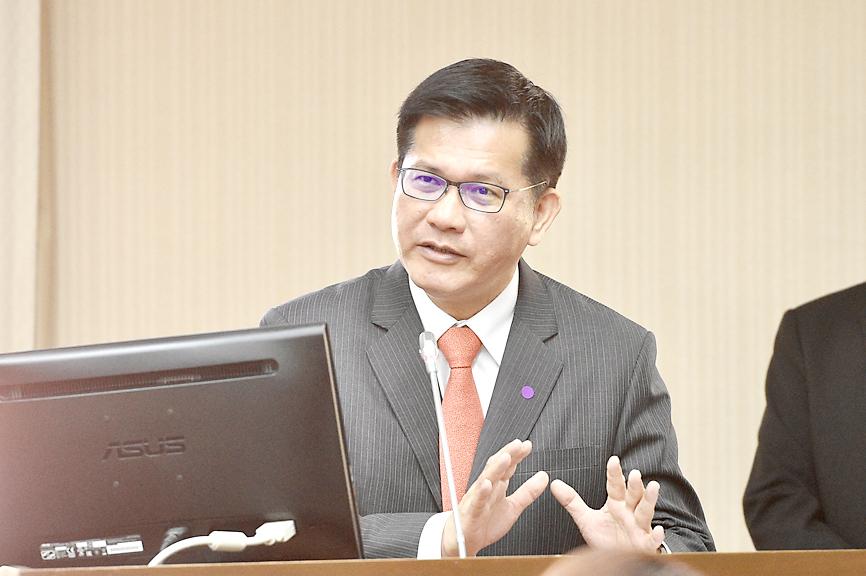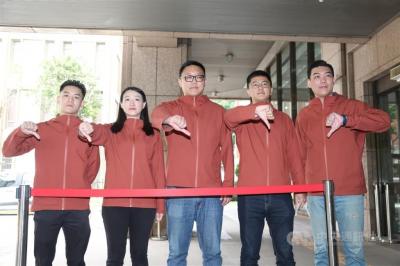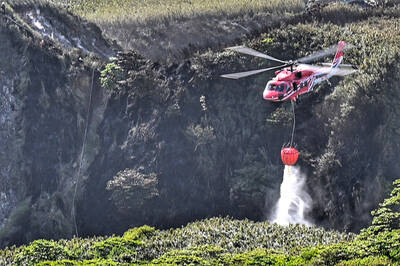Singapore has shown an interest in forming a travel bubble with Taiwan, Minister of Transportation and Communications Lin Chia-lung (林佳龍) said yesterday, adding that the government is in talks with Vietnam and Japan about similar deals.
Lin attended a meeting of the legislature’s Transportation Committee, which was scheduled to review the budget allocated for Tourism Development Funds and Freeway Construction Funds.
Chinese Nationalist Party (KMT) Legislator Hung Meng-kai (洪孟楷) asked Lin if the ministry has considered lifting the nation’s travel restrictions earlier than scheduled, given that Pfizer on Monday announced that it is making progress on a COVID-19 vaccine candidate.

Photo: George Tsorng, Taipei Times
Hung also asked if the nation’s plan to form a travel bubble with Palau was canceled because Palau questioned the nation’s testing of COVID-19 cases, and whether the nation could start travel bubbles with other countries, similar to those between New Zealand and Australia, and between Singapore and China.
Lin said that the Central Epidemic Command Center (CECC) would decide if Taiwan’s travel restrictions should be eased or lifted.
Palau is having a presidential election and is concerned that opening its borders would strain its disease prevention personnel and resources, he said.
Lin also told the committee that Singapore has been seeking a travel bubble deal with Taiwan and has contacted several government agencies, adding that he would soon meet with its local trade representative.
Taiwan is also in talks with Vietnam and Japan about forming travel bubbles with them, he said.
“We welcome similar proposals from other countries; we will tell them what we think are feasible solutions. However, any such travel agreement must first be approved by the CECC, which would determine whether an agreement can be enforced in ways that comply with the nation’s disease prevention policy,” he said.
As the government at the end of last month stopped granting subsidies for the second phase of “disease prevention tours,” Lin told reporters that the ministry plans to boost domestic tourism next month and in January with a winter travel subsidy plan, which it hopes would benefit travel agencies, tour guides, tourists and tour managers, and scenic areas.
“We will meet with officials in the six municipalities to see if they can offer more incentives to help keep the domestic tour market warm, or even heat it up a bit,” he said.
The bureau’s preliminary plan entitles tourists aged 55 or older traveling to Taipei, New Taipei City, Keelung, Taoyuan or Hsinchu to a travel subsidy of NT$1,500 (US$52.03) per room, which they would have to use between Feb. 8 and Feb. 13, before the Lunar New Year holiday next year.
People could present their ID numbers up to three times to apply for a subsidy, it added.
“Most domestic tourists traveled to destinations in central and southern Taiwan, as well as Hualien, Taitung and the outlying islands during the second phase of ‘disease prevention tours.’ We hope that we will help Taipei, New Taipei City, Keelung, Taoyuan and Hsinchu by breaking up the holiday traffic,” Lin said.
The government would also offer each domestic tour group a subsidy of NT$15,000 on condition that the tour lasts at least two days, and recruits self-employed tour guides and managers, he said.
The ministry has budgeted about NT$600 million for the initiative, which is expected to fund 36,000 tour groups.
To expand the scope of “pretend go abroad” tours, the Civil Aeronautics Administration has allowed civil aviation carriers to depart from Taiwan Taoyuan International Airport and land at other airports in the nation.

Taiwan is stepping up plans to create self-sufficient supply chains for combat drones and increase foreign orders from the US to counter China’s numerical superiority, a defense official said on Saturday. Commenting on condition of anonymity, the official said the nation’s armed forces are in agreement with US Admiral Samuel Paparo’s assessment that Taiwan’s military must be prepared to turn the nation’s waters into a “hellscape” for the Chinese People’s Liberation Army (PLA). Paparo, the commander of the US Indo-Pacific Command, reiterated the concept during a Congressional hearing in Washington on Wednesday. He first coined the term in a security conference last

Prosecutors today declined to say who was questioned regarding alleged forgery on petitions to recall Democratic Progressive Party (DPP) legislators, after Chinese-language media earlier reported that members of the Chinese Nationalist Party (KMT) Youth League were brought in for questioning. The Ministry of Justice Investigation Bureau confirmed that two people had been questioned, but did not disclose any further information about the ongoing investigation. KMT Youth League members Lee Hsiao-liang (李孝亮) and Liu Szu-yin (劉思吟) — who are leading the effort to recall DPP caucus chief executive Rosalia Wu (吳思瑤) and Legislator Wu Pei-yi (吳沛憶) — both posted on Facebook saying: “I

Sung Chien-liang (宋建樑), who led efforts to recall Democratic Progressive Party (DPP) Legislator Lee Kun-cheng (李坤城), was released on bail of NT$80,000 today amid outcry over his decision to wear a Nazi armband to questioning the night before. Sung arrived at the New Taipei District Prosecutors’ Office for questioning in a recall petition forgery case last night wearing a red armband bearing a swastika, carrying a copy of Adolf Hitler’s Mein Kampf and giving a Nazi salute. Sung left the building at 1:15am without the armband and covering the book with his coat. Lee said today that this is a serious

A mountain blaze that broke out yesterday morning in Yangmingshan National Park was put out after five hours, following multi agency efforts involving dozens of fire trucks and helicopter water drops. The fire might have been sparked by an air quality sensor operated by the National Center for High-Performance Computing, one of the national-level laboratories under the National Applied Research Laboratories, Yangmingshan National Park Headquarters said. The Taipei City Fire Department said the fire, which broke out at about 11am yesterday near the mountainous Xiaoyoukeng (小油坑) Recreation Area was extinguished at 4:32pm. It had initially dispatched 72 personnel in four command vehicles, 16